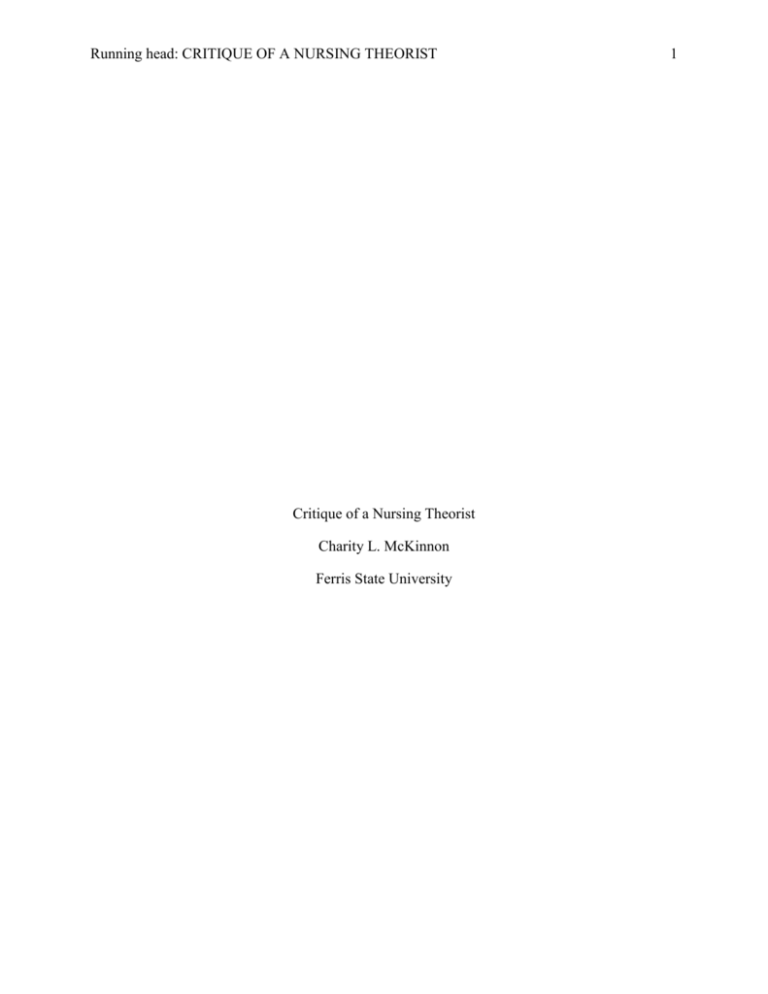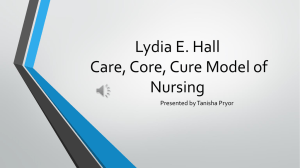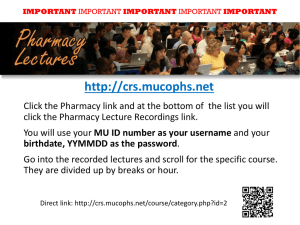Running head: CRITIQUE OF A NURSING THEORIST 1 1
advertisement

Running head: CRITIQUE OF A NURSING THEORIST Critique of a Nursing Theorist Charity L. McKinnon Ferris State University 1 CRITIQUE OF A NURSING THEORIST 2 Abstract This paper will discuss the nursing theorist Ramona T. Mercer. An analysis of the theory model Maternal Role Attainment will be analyzed regarding person, environment, health, and nursing. This paper will describe how Ramona T. Mercer’s theory is achieved and how it is applied to clinical practice. Strengths and limitations of the model will also be observed. CRITIQUE OF A NURSING THEORIST 3 Critique of a Nursing Theorist Introduction The middle-range theorist, Ramona T. Mercer, focused her ideas and nursing knowledge on Maternal Role Attainment-Becoming a Mother. Middle range theories are “more precise and focus on answering specific nursing practice questions, addressing the specifics of nursing situations within the perspective model or theory from which they are derived” (Tomey & Alligood, 2006, p. 8). Ramona T. Mercer has been a nurse for over fifty years, with a Ph.D. in maternity nursing (Tomey & Alligood, 2006). Her research on maternal role attainment began in the 1960’s and has developed into a widely used reference model by practicing nurses (Tomey & Alligood, 2006). The following paper will discuss the work Mercer has contributed to her specific nursing specialty. It will also review the impact her model has had on nursing practice and education, with an overview of strengths, limitations, and new insights about the model. Analysis of the Model Person Mercer’s model of Maternal Role Attainment-Becoming a Mother, defines the woman as a person retaining her “core self as she extrapolates herself from the mother-infant dyad” (Tomey & Alligood, 2006, p. 611). The mother is influenced by interactions with the baby and the father while attempting to attain self-esteem and self-confidence (Tomey & Alligood, 2006). A number of factors can affect these interactions, for example, if the mother and infant are separated, “maternal self-confidence and maternal attachment behaviors are affected” (Mercer, 1977, p. 1174). CRITIQUE OF A NURSING THEORIST Environment According to Mercer, maternal role attainment develops in an interacting environment (Tomey & Alligood, 2006). The woman and the changes occurring around her in the context of surroundings and relationships have an impact on “both maternal and paternal roll attainment and the developing child” (Tomey & Alligood, 2006, p. 611). “Transition to the maternal role involves many adjustments in a woman’s life. The ease or difficulty with which women take on the mothering role is influenced by both situational and individual factors, including maternal readiness for the role” (Mercer, 1986, p. 9). Health Mercer explains health status in the Maternal-Role Attainment theory as the parent’s “perception of their prior health, current health, health outlook, resistance susceptibility to illness, health worry or concern, sickness orientation, and rejection of the sick role” (Tomey & Alligood, 2006, p. 611). Health is viewed as an issue a family wants as an outcome that is an “indirect influence on satisfaction with relationships in childbearing families” (Tomey & Alligood, 2006, p. 611). Nursing Nursing is extremely important in the model of maternal role attainment because according to Mercer, “nurses are the health professionals having the most sustained and intense interaction with women in the maternity cycle” (Tomey & Alligood, 2006, p. 610). Mercer explains in one of her many publications, Becoming a mother: Research on Maternal Identity from Rubin to the Present, that 4 CRITIQUE OF A NURSING THEORIST 5 The kind of help or care a woman receives during pregnancy and over the first year following birth can have long term effects for her and her child. Nurses in maternal child settings play a sizeable role in providing both care and information during this period. (Tomey & Alligood, 2006, p. 611). “Maternal role attainment is achieved through interactions of mother, father, and infant” (Tomey & Alligood, 2006, p. 612). It consists of four stages: anticipatory, where the mother learns what is expected of the role; formal, where the mother gives birth and takes on the mother role; informal, where the mother develops her own ways of role attainment; and personal, where the mother internalizes the role (Tomey & Alligood, 2006). Bonding with the infant is a crucial part of the role attainment process and is influenced by many factors. Mercer states, “role identity has internal and external components: the identity is the internalized view of self and role is the external, behavioral component” (Tomey & Alligood, 2006, p. 613). Mercer revised the Maternal Role Attainment model in 2003, where she proposed “that the term becoming a mother more accurately describes the content of maternal role attainment” (Tomey & Alligood, 2006, p. 613). Mercer explains this is because becoming a mother is a never ending process and the woman adapts to each stage throughout life (Tomey & Alligood, 2006). Mercer’s model can be used in clinical practice because it can be utilized in “assessment, planning, implementing, and evaluating nursing care of new mothers and their infants” (Tomey & Alligood, 2006, p. 615). The nurse assesses and evaluates the patient situation-does she have support systems? Is the father involved? What is her financial status? Assessing aspects like these, along with community and societal factors will aid the nurse in planning care for the patient, therefore implementing with success the best outcome for mother and child (Tomey & Alligood, 2006). In my place of employment, fellow staff and I use an admission assessment CRITIQUE OF A NURSING THEORIST 6 specifically designed for parents-to-be. This is an informative way to receive the information to plan care for the patient. The context of Mercer’s model in nursing education is to simplify the process of becoming a parent (Tomey & Alligood, 2006). Students are able to refer to her nursing theory while learning to provide care to parents and experienced nurses use it as a guide while taking care of new parents (Tomey &Alligood, 2006). Nurses are able to reference Ramona T. Mercer’s theory in numerous amounts of nursing and obstetrical text books and journals (Tomey & Alligood, 2006). This assists nurses in the care of the patient in many healthcare settings. Strengths and limitations of Ramona T. Mercer’s theory can be described with clarity of the model, simplicity and generality of the model, and empirical precision of the model (Tomey & Alligood, 2006). Mercer makes “concepts, assumptions, and goals organized into a logical whole, making understanding the model easy. However, some interchanging of terms to identify concepts such as adaptation and attainment are potentially confusing for the reader” (Tomey & Alligood, 2006, p. 617). The model “can also be generalized to all women during pregnancy through the first year after birth, regardless of age, parity, or environment” (Tomey & Alligood, 2006, p. 618). Mercer’s “studies have spanned various developmental levels and contexts, involving the pregnant women’s partner and predicts parental attachment. This is not shared by other studies” (Tomey & Alligood, 2006, p. 618). Mercer has stayed abreast with her theory throughout the years with evolving research and has evaluated its currency and clarity. The model is predictable, making it simple for the nurse to use as a guide for practice and also addresses the aspect of empirical precision (Tomey & Alligood, 2006). CRITIQUE OF A NURSING THEORIST 7 Overall, the theory Maternal Role Attainment-Becoming a Mother by Ramona T. Mercer is an asset to nurses and their practice in many ways. She addresses the impact of a theory on practice by researching and updating her model. “We need theory to guide practice predictably and effectively to ensure that it serves the goals of the profession” (Kearney-Nunnery, 2008, p. 64). My only concern with the process she describes is that if I am dealing with a mentally incapacitated patient or someone of a different culture, if I would be able to use this model to the benefit of the patient. The theory takes nurses into the mother’s world, no matter what age, and helps guide the patient’s in the right direction. I believe that I will use this theory throughout my practice as an obstetrical nurse. CRITIQUE OF A NURSING THEORIST 8 References Tomey, A. M., & Alligood, M. R. (2008). Nursing theorists and their work (6th ed.). St. Louis, MO: Mosby. Mercer, R. (1977). Postpartum: Illness and acquaintance-attachment process. American Journal of Nursing, 77(7), 1174-1178. Mercer, R. (1986). Predictors of maternal role attainment at one year postbirth. Western Journal of Nursing Research, 8(1), 9-32. Kearney-Nunnery, R. (2008). Advancing your career: Concepts of professional nursing (4th ed.). Philadelphia, PA: F. A. Davis.









